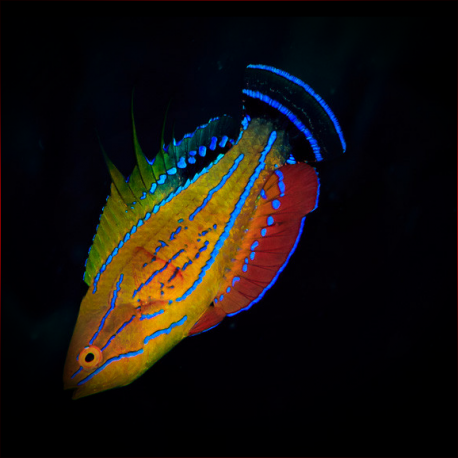More info
Datasheet
| Minimum Tank Size | 200 litres / 52.83 US gallons |
| Maximum Size | 8.0cm / 3.15inches |
| Reef Compatible | Always reef safe |
| Temperament | Might be aggressive towards similar species |
| Temperature | 22.2°C / 71.96°F - 25.6°C / 78.08°F |
| Specific Gravity | 1.020-1.025 |
| Carbonate Hardness | 8-12 |
| pH | 8.1-8.4 |
General Description
The Pink Flasher, scientifically known as Paracheilinus carpenteri, belongs to the Labridae family and is a vibrant Flasher Wrasse species found in the Western Pacific region. These wrasses are known for their colorful appearance and peaceful nature, preferring to spend most of their time in the water column. Males are particularly eye-catching, often sporting longer filaments on their dorsal fins.
Aquarium Suitability
This species is considered suitable for aquariums with care, as they can be aggressive if housed with similar species or if not provided with enough space. They are recommended to be kept as a pair (one male, one female) or with one male and multiple females to maintain harmony in the tank.
Demands, Care, and Hardiness
The Pink Flasher has average hardiness and is quite shy and docile, requiring careful consideration when housed with more aggressive tankmates. They need frequent feeding, especially when newly introduced to the aquarium, and benefit from a varied diet to maintain their health and coloration. Additionally, they are sensitive during transportation and acclimatization, so extra care is needed during these processes.
Reef Suitability
Pink Flashers are considered reef-safe and can be housed in reef aquariums without posing a threat to corals or other invertebrates.
Aquarium Setup
To cater to the needs of Pink Flashers, a tank size of at least 200 liters is recommended. The aquarium should be well-equipped with hiding places, such as live rocks, as these fish enjoy seeking shelter. Maintaining stable water conditions with a pH ranging from 8.1 to 8.4, a temperature between 22.2°C to 25.6°C, a KH level of 8-12, and a specific gravity of 1.020-1.025 is crucial for their well-being.
Behaviour
At night, Pink Flashers create mucus-covered cocoons between rocks for sleeping. They tend to hide initially when acclimating to a new environment and should not be disturbed during this period to facilitate a smooth transition.
Feeding and Diet
Pink Flashers feed on small crustaceans like krill, mysis, and artemia, as well as zooplankton such as Cyclops and pods. It is essential to provide them with a varied diet to ensure their nutritional needs are met.
Habitat and Distribution
In the wild, Paracheilinus carpenteri can be found in the Western Pacific region, ranging from the Philippines to Taiwan and Iriomotejima, and southward to northern Bali and Flores. Recently, these fish have also been recorded in Tonga.

